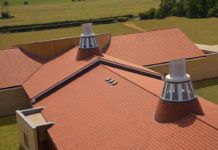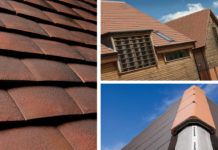 When I first came into the roofing industry some 30+ years ago, the concrete Double Roman tile was the most popular roof tile – certainly in my area – and was the first choice for many house-builders. The double Roman is an example of an almost perfect roof tile design; it directs water away from the side overlaps and interlocks; the channel between the roll is wide enough to drain water safely away; and the nail holes are protected from water ingress by being at the top of the rolls. Also, profile tiles such as the Double Roman and Double Pantile can be made much lighter with less material than a flat tile, because it is the shape that gives them their transverse strength.
When I first came into the roofing industry some 30+ years ago, the concrete Double Roman tile was the most popular roof tile – certainly in my area – and was the first choice for many house-builders. The double Roman is an example of an almost perfect roof tile design; it directs water away from the side overlaps and interlocks; the channel between the roll is wide enough to drain water safely away; and the nail holes are protected from water ingress by being at the top of the rolls. Also, profile tiles such as the Double Roman and Double Pantile can be made much lighter with less material than a flat tile, because it is the shape that gives them their transverse strength.
Scroll forward to present day and it is very much flat tiles that are our most popular roofing tiles in many areas of the UK. This has set roof tile designers several challenges to create tiles that can perform on the roof as efficiently as shaped tiles, particularly as the rising popularity of flat tiles has coincided with the trend towards lower roof pitches. The nature of a single lapped late interlocking tile means that on the roof, water is actually directed into the side laps and interlocks. In addition, there is no roll to protect the nail holes. Just to add to our challenges, flat tiles are very often the tile of choice on low pitched roofs.
Thick horizontal lines
Early designs of flat tiles are relatively bulky and heavy to achieve the required transverse strength; the tiles are around 30mm deep at their tails. This has led to the ubiquitous roofscape we see everywhere with the thick horizontal lines. Although you could also argue that the monotony of such roofs has encouraged architects to design extra features into roofs to add interest.
Consequently, this trend towards flat tiles has led to some great innovations in tile design that are perhaps not so obvious at first glance. Sandtoft’s latest entry into the concrete roof tile market is a great example of this. The TLE (get it? TLE – thin leading edge!) incorporates some great technical advances in roof tile design to make it perhaps the most efficiently performing roof tile on the market in terms of weathertightness. Through extensive wind driven rain testing in its wind tunnel facility at Goxhill, Sandtoft has been able to develop an extremely efficient side interlocking system that can accept and safely drain away rainwater, even in deluge conditions and at low roof pitches. This has even been achieved with side interlocks that have been reduced in width. The width taken from the interlock width has instead been added to the visible area, giving a 4% improvement in square metre coverage on the roof, making them faster to install. On flat tiles, rainwater can reach the nail holes through capillary action, therefore testing and careful design has produced the optimum position of the nail hole in the TLE for improved weathertightness at low roof pitches.
Computer analysis
Another great advancement in roof tile design has been the use of computer analysis to optimise material distribution within a tile to reduce weight whilst retaining strength. Again, the TLE is a great example of this; at only 19mm deep, it is one of the thinnest leading edge tiles around (Calderdale is 32mm deep at the leading edge), being around 13% lighter per laid square metre than the Calderdale tile, but yet just as strong. Therefore, the aesthetic of the roof is much improved and at the same time, reducing the overall structural loading.
The industry trend towards flat interlocking roof tiles has also driven some great innovations in cl




